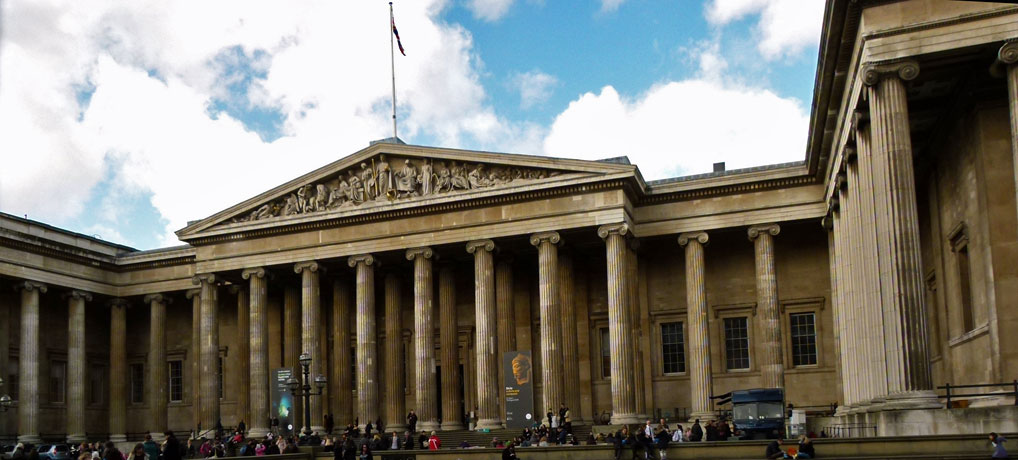Last updated on April 14th, 2025 at 02:25 pm

The British Museum is regularly at the top of the list of the most visited attractions in Britain. Something in excess of 6 million people – considerably more than the population of Denmark – walk through its doors and tour its galleries every year. It is an astonishing place which, in its own words, tells the story of cultural achievement throughout the world, from the dawn of human history over two million years ago until the present day.

In these testosterone-fuelled competitive times, it should be noted that the British Museum claims to be the first national and public museum in the world. It was established by an Act of Parliament in 1753 and opened its doors in Montagu House, on its present site in London’s then fashionable Bloomsbury area, on 15th January 1759. Doubtless, there are older museums, but they began as private collections. The Ashmolean Museum in Oxford is said to be the first public museum in Britain, opening in 1683; the Royal Armouries was entertaining visitors at the Tower of London much earlier, but wasn’t generally open to the public. However, the British Museum was founded for the benefit of a nation – though in so many ways it is now a museum of and for the world; more of that later.

The nucleus of the British Museum’s collections was formed from three sources. Firstly, the far-sighted MP Sir Robert Cotton (1571-1631) rescued and assembled a priceless collection of manuscripts which were donated to the nation by his grandson, Sir John Cotton, in 1702. So the Cottons were the first benefactors of the British Museum. The second, and most frequently mentioned, source for the origins of the British Museum was the personal hobby of Sir Hans Sloane (1660-1753). Sloane (certainly no square) was a renowned physician and a compulsive collector, who gathered some 71,000 objects in his lifetime – books, manuscripts, natural history specimens, curiosities – from all over the world. In his will, he left the whole lot to the British people, via King George II, in return for the paltry sum of £20,000 being paid to his heirs. (Now, there’s an idea for what to do with your collection of thimbles, tea towels, saucy postcards etc…) Thirdly, in 1753, the government purchased the Harleian Library, the collection of Robert Harley (1661-1724), 1st Earl of Oxford. In 1757, George II additionally presented the museum with the Old Royal Library, which had its roots back in the reign of dear old Henry VIII.

The museum’s collection has grown enormously since then, of course, and the buildings have changed somewhat. Work started on the present neo-classical building in 1823 and Montagu House was systematically demolished and replaced. Also in 1823, King George IV, better known for snuggling down with a naughty woman rather than a good book, donated his father’s library to the nation. Maybe it was no great personal loss. Anyway, all of these books and manuscripts, including the Cotton and Harleian Libraries, helped form the basis of the British Library – though this wasn’t established until 1973 and it didn’t finally move out of the British Museum until the late 1990s. In 1881, the natural history collection moved to the then new Natural History Museum at South Kensington. The removal of the library enabled the construction of the Queen Elizabeth II Great Court, the largest covered square in Europe, so they say, with the old reading room, built in 1857 and famously much used by Karl Marx, suitably clad and remaining in the centre. I couldn’t get into the old reading room during my last visit, but did see it in another life and it is just wonderful. The Great Court is light, airy and a place where the juxtaposition of old and new works beautifully. It is also here that you get a real sense of the British Museum being a repository for the whole world, simply by the babble of tongues all around; so many different languages from across the Globe. I love that; it reminds me what a generally and genuinely cosmopolitan place London is. It always has been, really. And, whatever our differing political views, everyone in this little island of ours should be proud of that – as well as of Britain’s reputation for being, mostly, a decent, tolerant, nation. I won’t put up with intolerance.

You get a sense of Britain’s long-established affable, hospitable and international roots when you visit the galleries that deal with the Celts, Romans, Anglo-Saxons, Vikings, Normans…and so on…all of whom were made to feel so welcome when they arrived. But we cannot visit the British Museum without noting that it is in itself something of a reflection of Britain’s more recent past. Provided nothing disturbed the balance of power, from the 18th to the early 20th centuries, Britain’s interests lay primarily outside its immediate European surroundings. So should we be surprised that, in terms of floor space, the museum galleries dealing with Britain and Europe are dwarfed by those dedicated to the ancient civilisations of Asia, the Middle East, Egypt, Greece and Rome? I guess, too, that all museums reflect what they are able to get their hands on. Anyway, the classical world appears to dominate – possibly due to the fascination that was fashionable during the museum’s formative years, no doubt aided by relative ease of access and a bit of cash. Interestingly, the American and African galleries are tiny in comparison with any others. Nevertheless, gazing in awe at the magnificence and range of exhibits, realisation rapidly dawns that so many of these things would be somewhere else were it not for the fact of Britain’s old Empire and, beyond that, its then position as a global superpower.

However, whilst I have no idea how the majority of the collection was acquired, it would be ridiculous and ignorant to suggest, as some do, that the British Museum is full of imperial plunder. Greece, notably, was never part of the British Empire. Many objects were obtained simply because someone rich enough was prepared to pay for them, and someone in the country of origin wanted the dosh more than bits and pieces of cultural heritage. Whether they had the authority, moral or otherwise, to make the trade is another matter. However, there are objects that were obtained in dubious circumstances that simply wouldn’t happen today. These include the Benin Sculptures, looted during a violent punitive raid as recently as 1897, indigenous items from Australia simply taken from the time of Captain Cook onward and the Rosetta Stone, discovered by a French soldier in 1799 and removed as booty by the British in 1801.



Possibly the most famous controversy focuses on the Elgin Marbles – or Parthenon Sculptures as less populist commentators more accurately prefer to call them. Yes, I too used to think these were a Scottish version of the small glass balls we used to play with at school: they’re not. Briefly, the facts behind the Parthenon Sculptures at the British Museum are that Thomas Bruce (1766-1841), 7th Lord Elgin, art-lover and ambassador to the Ottoman Empire – which at that time included Greece – gained permission from the Ottoman authorities to remove any pieces of stone with inscriptions or figures on them from the 2,500 year old Parthenon in Athens. Probably, some money changed hands. Anyway, between 1801 and 1805, Elgin shipped about 50% of what was there back to Britain at his own expense and several years later sold them at a substantial loss to the British Museum for £35,000. Elgin’s actions were criticised at the time by the poet, Byron, and others. But the hullabaloo really took off relatively recently and still rages today, with the Greek authorities maintaining that the museum does not have legal title to the items and that they should be returned to Greece before the next marathon.

This business of provenance and acquisition can obviously be contentious and it requires knowledge beyond my fingertips to debate fully. Clearly, it is understandable that some people ‘want their treasures back’. It is also true that in some cases the artefacts have been better protected and preserved for the world by being in a particular museum than they would have been if they had been left in situ. It is also true that returning objects to their countries of origin would empty the museums of the world – certainly those in the First World; Britain is not alone in holding objects acquired from other cultures, including by means that some find unacceptable today. But where would this end? Have people nothing better to do than attempt to trace the provenance of every item in every museum’s collection and decide who ‘owns’ it? Who owns heritage anyway? Should military museums, for example, return objects removed from the battlefield, or taken from defeated enemies? Come to think of it, let’s have a word with the Vikings about the stuff they pillaged from our monasteries in the 9th century. Oh – wait; whose monasteries were they? Applying today’s standards to rectify the wrongs of the distant past is often pretty pointless; we just need to do better in the future. Mind you, it’s easy for me to say; no one’s come along and nicked Stonehenge.



As things are, whilst I’m sure the British Museum is far from perfect, I’m equally sure that it’s a first-rate custodian of our heritage. And I know it’s a superb place to visit. Also, apart from special exhibitions, admission is free – as is admission to other national collections in Britain. To cap it all, if you’re so inclined, it has a first class shop, a kind of Harrods of visitor attraction shops, which sells beautiful, and costly, baubles.

It’s such a massive place, where you can visit time and again and always see something new (as well as catching up with old friends). If you live in London, you really do have a treasure on your doorstep. A few of my favourites are pictured (as always, labels or comments appear if you hover your cursor over the photo). It’s impossible to do justice to the massive range of items at the British Museum – go and see it yourself, if you haven’t already.


But I want to return to the international angle mentioned earlier. Here in the British Museum are people from all over the world seeing objects from all over the world across a range of cultures and historical periods which, collectively, have been part of our shared journey to the present. It’s a fantastic showcase for the achievements and failures of humanity, irrespective of race, colour, tribe, or creed. Now, there is obviously reasonable communication between collections, nationally and internationally – one visible consequence of this is the various loans made between institutions. What a wonderful vehicle heritage should be for multi-cultural engagement and enlightenment.

I really enjoy the British Museum and I am long overdue a visit 🙂
I am so pleased we have wonderful places like this to visit …
All the best Jan
I have visited!!! I did not make it thru the entire museum, but what I did was amazing. I would enjoy going back and taking my boys along with me.
You won’t put up with intolerance! 😀 ahem.
I love museums – we have a very nice one in Hartford; another in Springfield.
We did a stop in at the British Museum when we were in London in 2014. I had to see the Rosetta Stone. We were overwhelmed by the crowds. We did manage lunch in that center part upstairs and it was quite good if I remember. We spent more time in the London Museum tracing the beginnings of human settlement on the island. Less crowds for sure.
I’m a V&A fan personally. Like you say, the bit of BritMus devoted to Brit is rather small, and the bit of Brit that interests me, even smaller. (Prehistory, if I’m honest. Yes, I know that makes my brand name a little misleading.) I’m on the side of the Greeks in the case of the Parthenon sculptures, but given what certain extremist groups are doing currently in some parts of the word, it’s just possible that the only surviving treasures from some ancient cultures will be what’s on show in BritMus. It’s a tricky question.
Mike, I haven’t visited this museum since I was a child! I forgot just how incredible the place was and how enormous. Will have to rectify that this year at some point!! Take care.
I think you did the museum justice, on both sides of the issue. I’m intrigued by the Isle of Lewis chessmen, and the controversy over their location, but I think the tour that a portion of them did through Scotland went a long way to balance things. Here in our national museum there’s a huge display of west coast native cultures, but the native communities themselves sent craftsmen to build the display houses. Another balance struck I think. But the case of First Nations burials in North America is a little more challenging; sometimes they are relatively recent, and there have been a number of repatriations.
Looks amazing – have not been there for many years!
Hi Mike – wonderful write up on the Museum … exceedingly difficult to give it its due justice … it is an extraordinary place … I really don’t visit the Greek, Roman etc exhibits – I aim for the special exhibitions, which one needs to pay for, or go to the free ones on the 4th floor usually of unique type collections … there was one on Bark Cloth in the islands of the Pacific … I love those tiny collections they put up – also the large public ones (that cost) – the Viking one and the Celtic one were exceptional.
Love the Waddesdon collection – by the Rothschilds and the clocks … it’s an amazing place … I do go there quite often …
Brilliant post – thank you – Cheers Hilary
We love the British Museum and always try and visit when we’re in London. Usually it is heaving with people which is both good and bad. On our last visit we concentrated on the Anglo-Saxon section of the museum.
Hmmmm…. good idea, I was wondering what to do with all those saucy postcards, now I know! I’ve never been to the British Museum, probably because I’ve never spent enough time in London to allow a visit. Perhaps one day. Certainly a museum for the whole world. But I can understand why some cultures want their treasures returned. But those cultures didn’t really view the items as treasures when they were allowed to be taken away/bought/stolen by foreigners.
I’ve never been to the British Museum, the only London museum I have been to being the Natural History Museum. Your excellent commentary and photos have made me realise that another visit to London is needed! I enjoyed reading your presentation regarding the origins of the museum and the controversy of the various artefacts, and appreciate your nice touches of humour. London in the spring sounds good…
So far, I have only made it to the museum twice, which means I have managed to see only a minuscule fraction of what it holds. Both visits were overwhelming by the sheer abundance of “things”! The Museum of Natural History is another really great one, as is the V&A and many others. Have you been to Soane’s (no typo – I don’t mean Sloane) museum? It is one of the most fascinating places I have ever come across. Click here if you want to know more.
The chap you can’t remember where he’s from: my guess is Mesopotamia.
And the Egyptian guy could be Rameses – or someone entirely different.
Thanks, Meike! All of those places are listed on the attraction directory. I think you’re right about Mesopotamia.
Excellent post, Mike! I agree with all you you have said and the photos are wonderful. I love the museum but never have the time or energy to see all I want to.
The British Museum really is a museum for the whole world. You should be very proud of it!
I never tire of visiting there. In fact, I wish they would let me live there, I could live in a small closet there and be happy!
I love visiting The British Museum – I usually pick just three or four items that I particularly want to see.
Thanks for the look at the place! I’d love to visit there myself someday.
Wow what a place
Excellent, Mike! Very fair, reasonable, and well done! Can’t wait until Stonehenge is on exhibit at the Field Museum in Chicago. 😉